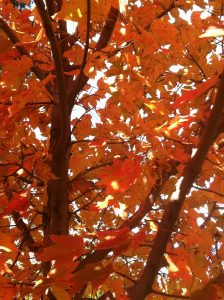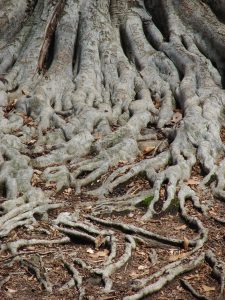 Send to Kindle
Send to Kindle It’s that wonderful time of year when the leaves turn from their summer green to shades of gold, red, yellow, orange and everything in-between. The colors are especially beautiful in Vermont and New Hampshire at this time of year, when the roads become gridlocked with Leaf Peepers. Like me, those who travel from far away to view the spectacular show of color get the chills at first seeing them and can’t stop pointing out the magnificence that surrounds them as they fly into or drive through the Green Mountains.
It’s that wonderful time of year when the leaves turn from their summer green to shades of gold, red, yellow, orange and everything in-between. The colors are especially beautiful in Vermont and New Hampshire at this time of year, when the roads become gridlocked with Leaf Peepers. Like me, those who travel from far away to view the spectacular show of color get the chills at first seeing them and can’t stop pointing out the magnificence that surrounds them as they fly into or drive through the Green Mountains.
Here in Virginia we do have an array of fall colors but not the stunning Crayola colors that we see when going to northern climes. Still it’s lovely and amazing to watch. One of my favorite things to do is to walk slowly on a windy day as the leaves drift all around me. I love the crunch underfoot and the storm of falling foliage overhead, just as much as I love walking through the first snowfall of the season, when my breath steams away and the building layers of snow on the ground quiets the sound of the passing world.
Bill and I both love trees and have always used them to welcome in new babies. After Mark was born in Vermont on a fifty-below-zero night in February, 1967, we planted a tiny weeping willow the following spring to honor him. Three years later when Lisa joined us, we planted another near the first one. We also honored our granddaughter Zoe, with a willow on her first birthday. And three years later when Noah, arrived from Guatemala as a one-year-old, we planted a red bud to honor him.
 I’ve just finished reading, The Hidden Life of TREES, What They feel, How They Communicate, Discoveries from a Secret World, by Peter Wohlleben. If like me, you are a nature lover, have been mystified by the life of trees and plants in general, and weep whenever land is cleared of trees for more buildings, here is the story of how these marvels of nature live there lives through hundreds, sometimes thousands of years. They communicate with each other, as they nurture their children and friends through an underground mycelial network of underground fungal species. It’s a marvelous read.
I’ve just finished reading, The Hidden Life of TREES, What They feel, How They Communicate, Discoveries from a Secret World, by Peter Wohlleben. If like me, you are a nature lover, have been mystified by the life of trees and plants in general, and weep whenever land is cleared of trees for more buildings, here is the story of how these marvels of nature live there lives through hundreds, sometimes thousands of years. They communicate with each other, as they nurture their children and friends through an underground mycelial network of underground fungal species. It’s a marvelous read.
It seems we humans treat our tree and plant friends as badly as we treat our animal friends. It’s time to learn about them and come to their aid. You won’t be disappointed in what you learn in the marvelous book.
Are you a tree hugger? I am.

I love the majesty of trees. The protection that they can provide. How deep their roots go, they are like ground bound icebergs. For the fruit that they supply. I have a beautiful oil painting that my son gave me a few years ago, it is a grove of standing trees, it is a beautiful forest that I can step into at anytime. I enjoy listening to the leaves rustling in the wind.
I’m glad you also love trees. They not only protect us in so many ways, but they also provide us with air-conditioning in the summer time. When we moved here six years ago the crepe myrtle trees in my back yard were not much taller than I am. Now they tower over the roof, keeping the hot summer sun away for many hours in the heat of the day.
Joan — The Hidden Life of TREES, What They feel, How They Communicate, Discoveries from a Secret World, by Peter Wohlleben is on my to-read list. I’ve just moved it up a few notches. Thank you!
I think you’ll be glad you moved it up a notch or two. It really is a fine read. I kind of intuited that trees communicate with each other, and this book shows us how.
Carol fox:
November 1, 2016:
Hi Joan,
Just got back from Vermont and now I am an avid leaf and tree lover! Living in CA one can be very snobbish about mountains and trees, but I was electrified by The Green Mountain beauties.
Loved your book, gave it five stars, and now am an avid follower! Identify with being overwhelmed. Too much eye candy around to stay focused on what feels like work. I will put the Hidden Life of Trees next on my read! Good luck with the bucket list.
Oh, Carol, I’m so glad you went and saw Vermont during it’s best season. Welcome to the world of tree lovers And thanks for loving my book and being a follower!! Miss you!! Could use a visit and some laughter.
Lovely sensory description, a treat to read, Joan.
Thank you so much, Marian. i’m so glad you enjoyed walking with me!
Joan, I have always loved trees. Several years ago a tornado leveled some trees in a nearby area and swear I could hear the surrounding trees weep. I felt the loss on a deep level. THE HIDDEN LIFE IF TREES is now on my to-be-read list. Thank you.
Oh yes, I’ve had a similar experience to yours. While driving through the Olympic forest in Washington state, we came upon an area that was clear cut. I started crying and Bill asked me what why I was in tears and it was because I could hear the downed trees weeping. They are after all real living beings.
Hello Joan, at first read, I thought you might be right here in Vermont. If so, I do hope we can finally get our hubs to meet. Let me know.
I enjoyed your post very much. It makes me think again of this majestic “wolf tree” we discovered across the road during our first winter here. As you know, Vermont was a wonderland of sheep farms up until about 100 years ago when the beef industry put an end to lamb as America’s preferred meat. So, the sheep farms were abandoned and the gorgeous foliage we now enjoy so much moved in. As a result most of vermont’s forests are less than 80-100 years old. EXCEPT for the occasional “wolf tree” one comes across. And we wind up with a few. These were trees that were allowed to stand in the open sheep grazing areas, maybe to supply shade for the shepherd or the sheep. They grew wide and full , unlike most of our trees today, as there was no competing trees nearby. So, deep in our fir forest, the loggers (taking the fir — and I can make a great case for doing so) uncovered this majestic birch tree. I once envisioned the Chincoteague picnic table beneath its branches, but instead we’ve let the fir move in again. They are pioneer trees that tend to have a natural life span of no more than 30 years. When they die, they tend to fall over, taking other, healthy and longer-living trees with them. So, when the fir is about 20 – 25 years old, we are to get the area “logged” — which means taking the pulp wood (soft fir) down. That way you can have paper to make books out of. 🙂 It’s a lovely world, the way each part is connected to the whole.
So sorry to say I’m not in Vermont, Janet. Don’t know when we’ll get up there either. With Bill’s surgeries this year we haven’t traveled much at all. We’ll see what opens up in the new Year. We want to travel but the bucket is overflowing with places we want to see for the first
time and to return to. So who knows.
I think you’ll really like the book I talk about here. Those wolf trees are so rare because so many trees prefer to live in a community. Trees often planted without their families with them fail quickly, never reaching full maturity. It is all quite amazing.